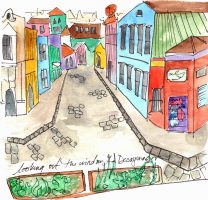Support Hidden Compass
Our articles are crafted by humans (not generative AI). Support Team Human with a contribution!
I kick my flippers hard to catch up to Alfred “Touché” Gray, an Indigenous Land and Sea Ranger. We’re snorkeling at night above one of the 3,000 coral reefs that make up Australia’s Great Barrier Reef, and his flashlight is the only thing keeping the darkness of the ocean from swallowing me whole. I try not to think about what else might be swimming through these waters, unseen in the sapphire-black of night. Instead, I keep my focus on the beam of light emanating from Touché — it has suddenly stopped moving.
I freeze, drawing in shaky gulps of air through my snorkel. Touché is merely a silhouette. My eyes follow his flashlight’s beam down to the finger coral below. Touché jack-knifes his body and dives. I inhale and follow. We are side-by-side now, making our way deeper toward the reef. He’s gesturing wildly to me, but I’ve already seen them. Thousands of small, iridescent globules. He spins, the light cascading in a circle so I can see we’re surrounded, like being in an underwater snowstorm.
I need oxygen, so I kick for the surface. I pop my head up and blow hard to clear the water from my snorkel. The night air smells of brass and brine. Touché surfaces a moment later, pulls his snorkel from his mouth, and lets out a whoop. I raise my face to the nearly full moon and howl. This is what I came to see. The corals of the Great Barrier Reef are spawning — one of the greatest reproductive shows on earth.
I fill my lungs and dive back down for more.

During a spawning event, established coral — like the leather coral pictured here — eject thousands of bundles of egg and sperm. Photo: Jurgen Freund / Alamy.
~~
Underwater, the finger corals glow creamy peach in Touche’s light, appearing like a forest of miniature tree trunks with bare branches. It is a common misperception that corals are plants. They are animals — marine invertebrates that live in colonies and, when the conditions are right, reproduce by spawning. This year, their spawn is part of a groundbreaking conservation effort to restore sections of the Great Barrier Reef that have been damaged by climate change.
A better-known fact about corals is that they are builders. Certain species secrete layers of calcium carbonate, also known as limestone, which creates reefs. The Great Barrier Reef (GBR) is the largest living structure on the planet. It is visible from space, stretching for 1,429 miles along the northeast coast of Australia.
Many who have had the privilege of snorkeling or diving off the coast of any of the more than 100 countries with coral reefs know that these structures also support a dizzying array of other lifeforms. Though these reefs make up less than 1 percent of the world’s oceans, they support a whopping 25 percent of the world’s marine species.
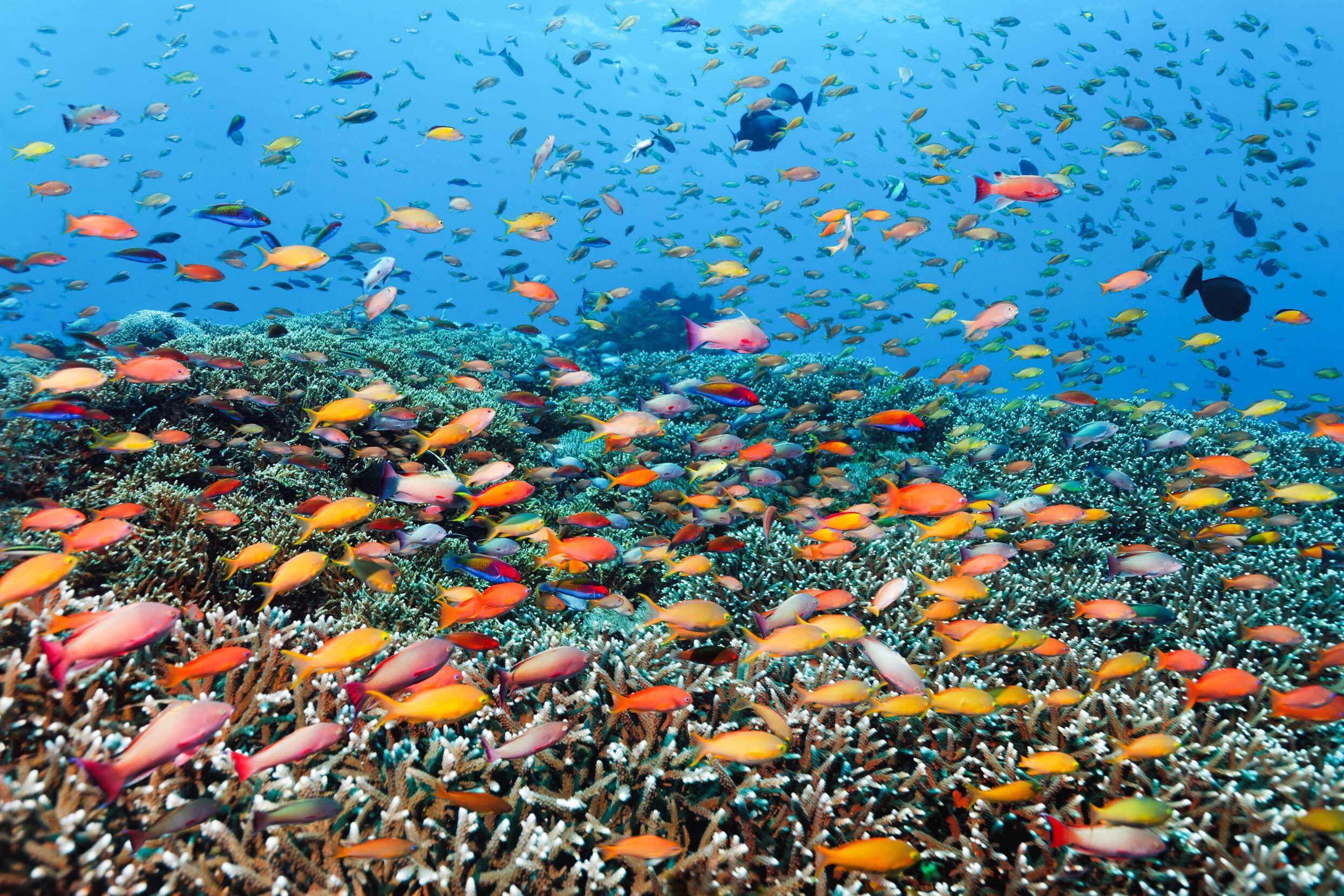
A rainbow confetti of fancy basses, Anthiinae, swim over the coral colonies of the Great Barrier Reef. Photo: Norbert Probst / Alamy.
Humans thrive in their presence, too. An estimated 1 billion people worldwide benefit directly or indirectly from coral reefs through fisheries, tourism, or through the shelter reefs provide coastal areas from waves and storms. In Australia, the GBR contributes $6.4 billion annually to the national economy, 90 percent of which is from tourism.
Coral reefs also have significant cultural value for Touché and many other Traditional Owners. Traditional Owners are descendants of tribes and ethnic groups, also known as First Nations Australians, who were the original inhabitants of Australia before European colonization and whose First People rights and responsibilities are protected under Australian law. Touché calls the GBR “the great mother.” She spawns in November and December, Australia’s late spring/early summer, when the waters of the Coral Sea begin to warm.
For most corals, the spawn happens after dark for a few nights following the full moon, when tide fluctuation is most negligible. At that time, coral colonies across the GBR are simultaneously ejecting trillions of tiny bundles of egg and sperm, collectively called gametes, out into the ocean.
I raise my face to the nearly full moon and howl.
Very few humans have been under the sea with a flashlight at precisely the right moment to bear witness to the spawn, let alone snorkel through a tropical snow globe of gametes. As a journalist from Canada, it is certainly my first time.
Touché is part of the Indigenous Land and Sea Ranger program, a partnership since 2007 between First Nations and the Australian Government that combines Traditional Owner knowledge and cultural practices with Western science to better manage natural resources. Prior to this project, he had always worked on the land. In his new role as a Sea Ranger, Touché is being trained in coral reef restoration. And he is loving it. He tells me he has barely slept since the spawn started, preferring night snorkeling and stargazing to sleep.
As he will say multiple times during our two days together, with wide eyes and an even wider grin, “I don’t want to miss anything.”
Over the next 45 minutes, the bundles around us will float up to the ocean’s surface. There, the egg and sperm will separate and seek out a mate from a different colony of the same species. If all goes as nature intends, a match is made, and a coral embryo forms. The embryo will remain floating on the water’s surface for a few days as it grows into a larva. Then, it will sink back to the ocean bottom to find a stable surface to attach to and develop into an adult.
Unless it’s caught first.
~~
A coral embryo runs the risk of being gobbled up by fish or other animals in the water column. Other embryos can float too far from the reef and find themselves without a home to settle on. Still others can be captured in the net of a human, which in this case turns out to be a good thing.
The morning after the spawn, I shadow Touché during a training session. His instructors are scientists working for the Reef Cooperative, the name of the $2-million restoration project, as well as the name of the team deploying it. This is a first-of-its-kind fusion of Indigenous Land and Sea Rangers, marine biologists, ecologists, and tourism operators. During the spawn, the team is based on a two-story pontoon boat that is permanently anchored 28 miles off the coast of Cairns, Queensland. The pontoon was originally designed for tourists, who use it as a basecamp to snorkel. For this project, it’s doubling as a floating laboratory.

The Reef Cooperative uses a pontoon anchored 28 miles off the coast of Cairns, Queensland, in Gunggandji Sea Country as its floating laboratory. Photo: Experience Co.
Touché is being trained in a coral reef restoration technique known as larval reseeding. Australian scientists first pioneered larval reseeding, also known as coral IVF, on the Great Barrier Reef in 2016. The technique involves capturing some of the spawn from a healthy section of the reef and protecting it in floating pools to maximize the number of embryos that survive. The embryos are then transported by boat to a damaged section of the reef and released there, helping to repopulate the damaged section’s coral cover faster than it could have on its own.
The Reef Cooperative’s scientists occupy a small room on the pontoon’s upper deck. Peering into microscope #1 is Dr. Kerry Cameron, who holds a PhD in the restoration of coral reefs using larval reseeding. Beside her, seated at microscope #2, is Dr. Katie Chartrand, a senior researcher with James Cook University’s Centre for Tropical Water & Aquatic Ecosystem Research. Behind them, a row of windows spanning the length of the room is open to the turquoise sea beyond. A warm, salty breeze rustles the top page of my notebook.
“They’re at the prawn chip stage,” Kerry says, looking up from her microscope with a smile.
She’s talking about the spawn I swam through last night, which is starting to develop. Earlier that morning, Touché was busy using a large net to scoop up coral embryos floating on the water’s surface — unmistakable due to their bright orange color — and corral them in one of four floating enclosures just beyond the pontoon. The enclosures protect the coral larvae from being eaten or floating away while they develop.
Kerry rises from her seat so I can look into the microscope. I notice she wears long sleeves and pants, even in the 80-degree heat of late spring, to give her skin a break from the otherwise constant sun. Peering through her lens, I see what appears to be a miniature version of the crispy fried crackers I know from Chinese restaurants.
“So these are baby corals,” I marvel.
“Well, technically, they’re embryos,” she says. “In a couple more days, they’ll be baby corals. It’s looking really good so far.”
The soon-to-be baby corals are destined for a section of the GBR known as Hastings, located about 30 miles away. Traditional Owners have identified Hastings as being both culturally and economically important. But it’s in peril. The Reef Cooperative’s scientists have confirmed it may not survive without intervention.
His flashlight is the only thing keeping the darkness of the ocean from swallowing me whole.
~~
Hastings Reef has endured a double-whammy of climate change disturbances. Surging waves from cyclones, including Ita in 2014, broke off portions of the reef’s corals and pulverized them into rubble. And periodic heat waves, most notably in 2016, spiked the water temperature, resulting in mass coral bleaching.
In the pontoon boat’s makeshift laboratory, Kerry explains bleaching to me and Touché. It’s more complex than it seems. Corals are actually colorless by nature, “clear, like jellyfish,” Kerry says. Corals’ dazzling colors come from an algae that takes up residence in their skin. Kerry compares the algae to solar panels, converting sunlight into sugar and oxygen, which provides energy for the corals. The corals reciprocate by producing carbon dioxide, an essential input for algae’s photosynthesis. “It’s a beautiful symbiotic relationship,” she says.
Bleaching happens when the water temperature rises 4 degrees Fahrenheit (2 degrees Celsius) above the average summer maximum temperature for their region, and corals overheat, which makes them “spit out their algae,” as Kerry puts it. Without the algae, corals return to their colorless state. And worse — they slowly begin to starve because the algae’s photosynthesis was the corals’ primary energy source.
However, Kerry says that bleaching is not necessarily a death sentence. When the heat wave ends and the water temperature returns to normal, corals reacquire their algae. “Corals can survive maybe up to six weeks without algae,” she says. Unfortunately, at Hastings, the high water temperatures persisted longer than most corals could handle. At the time of reseeding, the reef’s coral cover was down to just 15 percent.
~~
Touché and I take a short lunch break, digesting what we’ve just learned along with plates of pasta and salad courtesy of the pontoon boat’s cafeteria-style kitchen. We are sitting side-by-side at a picnic table, staring out at the seemingly infinite sea, when I ask him to explain his use of the word “country.” For Touché, the land is Country with a capital “C.” The ocean is Sea Country, also capitalized.
“It doesn’t mean geography, like I live in this country or that country,” he says. “Country is all the living things, the stories, the spirits, and our responsibilities to them all.”
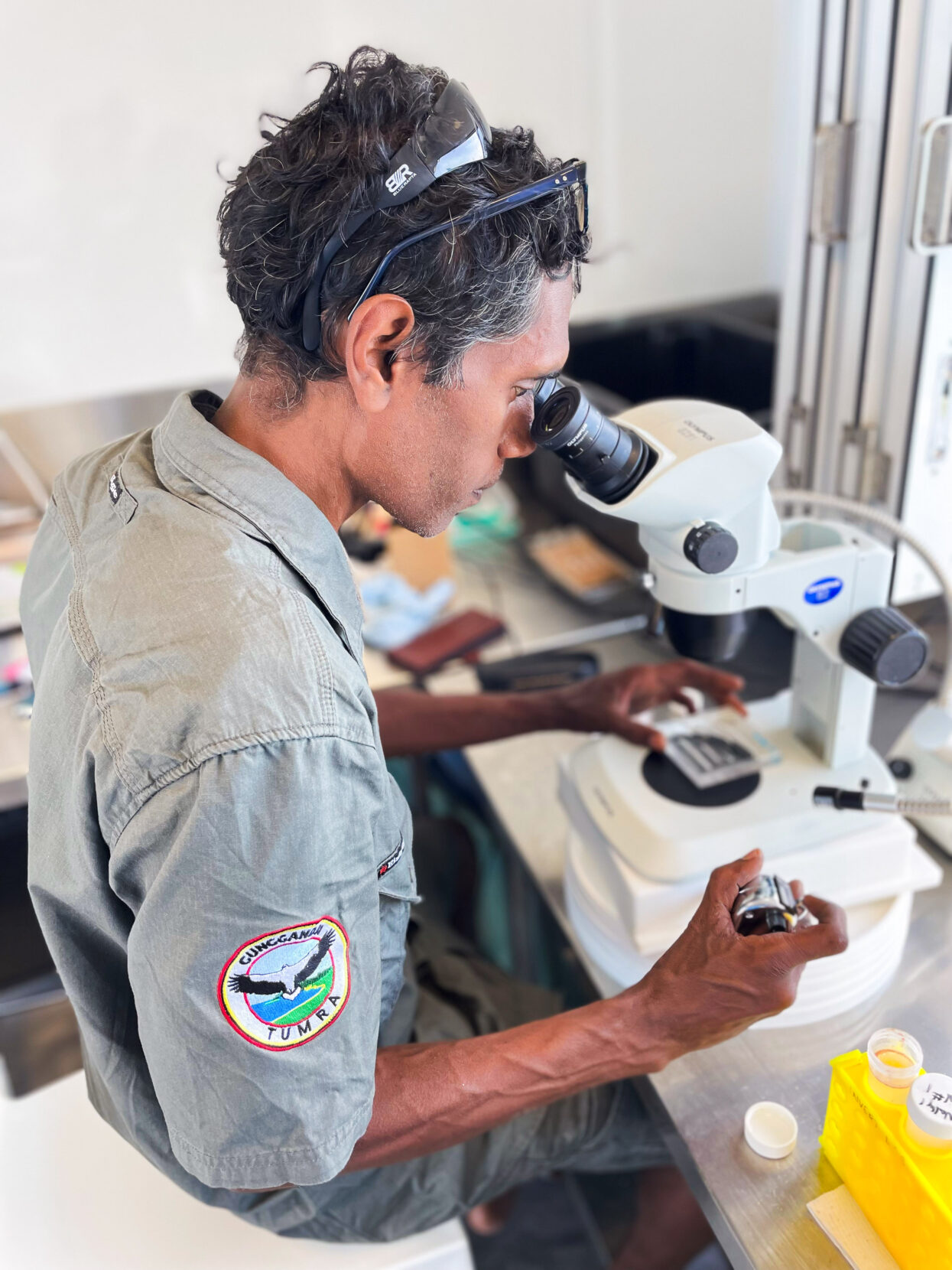
Alfred “Touché” Gray, an Indigenous Land and Sea Ranger, is being trained in coral reef restoration. The Ranger program stems from a partnership between First Nations and the Australian government. Photo: Dr. Katie Chartrand.
The pontoon is anchored in what is considered Gunggandji Sea Country. Touché’s people are the Gunggandji; they hail from the area in and around the coastal town of Yarrabah, just southeast of Cairns. I suddenly realize that is what the patch on the sleeve of his khaki button-down shirt, the one with the seagull on it, says. The word “Gunggandji” stretches across the top of the patch, while “Land and Sea Rangers” spans along the bottom. But, as Touché explains, calling it Gunggandji Sea Country does not imply possession. It means stewardship: This is the section of the sea that the Gunggandji steward.
When the coral babies are transported to Hastings Reef, in neighboring Yirrganydji Sea Country, that is the section of the sea that the Yirrganydji steward. Touché says he’s delighted to help his “brothers and sisters.” He is not only talking about the Yirrganydji people but also the corals themselves and all the creatures that live in the GBR.
Though these reefs make up less than 1 percent of the world’s oceans, they support a whopping 25 percent of the world’s marine species.
I am inspired by everything I’m hearing and seeing. But as a journalist, I am also skeptical. Climate change is not going away. Won’t there continue to be heat waves and extreme cyclones, which will continue to damage coral reefs? And isn’t it possible that the water temperature of the Coral Sea could rise permanently, killing off the entire GBR?
After lunch, I head back to the lab with my questions. Kerry and Katie both fix their eyes on me as I speak. But neither of them appears alarmed. Katie is the first to reply.
“The short answer,” she says, “is yes.”
She goes on to explain that she and her colleagues are aware that the work they are doing may not matter in the end if society can’t figure out a way to decrease carbon emissions. At the same time, there is also a chance that humanity’s efforts will be enough to keep the worst effects of climate change at bay and that the GBR will survive. Or could have survived, anyway, had it had continued support from projects like this one.
“We can’t just stand by and do nothing,” Katie says, speaking of the marine biology community.
She also sees value in the short-term benefit of the Reef Cooperative’s work: “If we’re getting positive outcomes, if we’re having impact at a scale that’s meaningful while also producing important data, and if we’re building skills and capacity to create jobs and opportunities for Traditional Owners, then it’s worth it.”
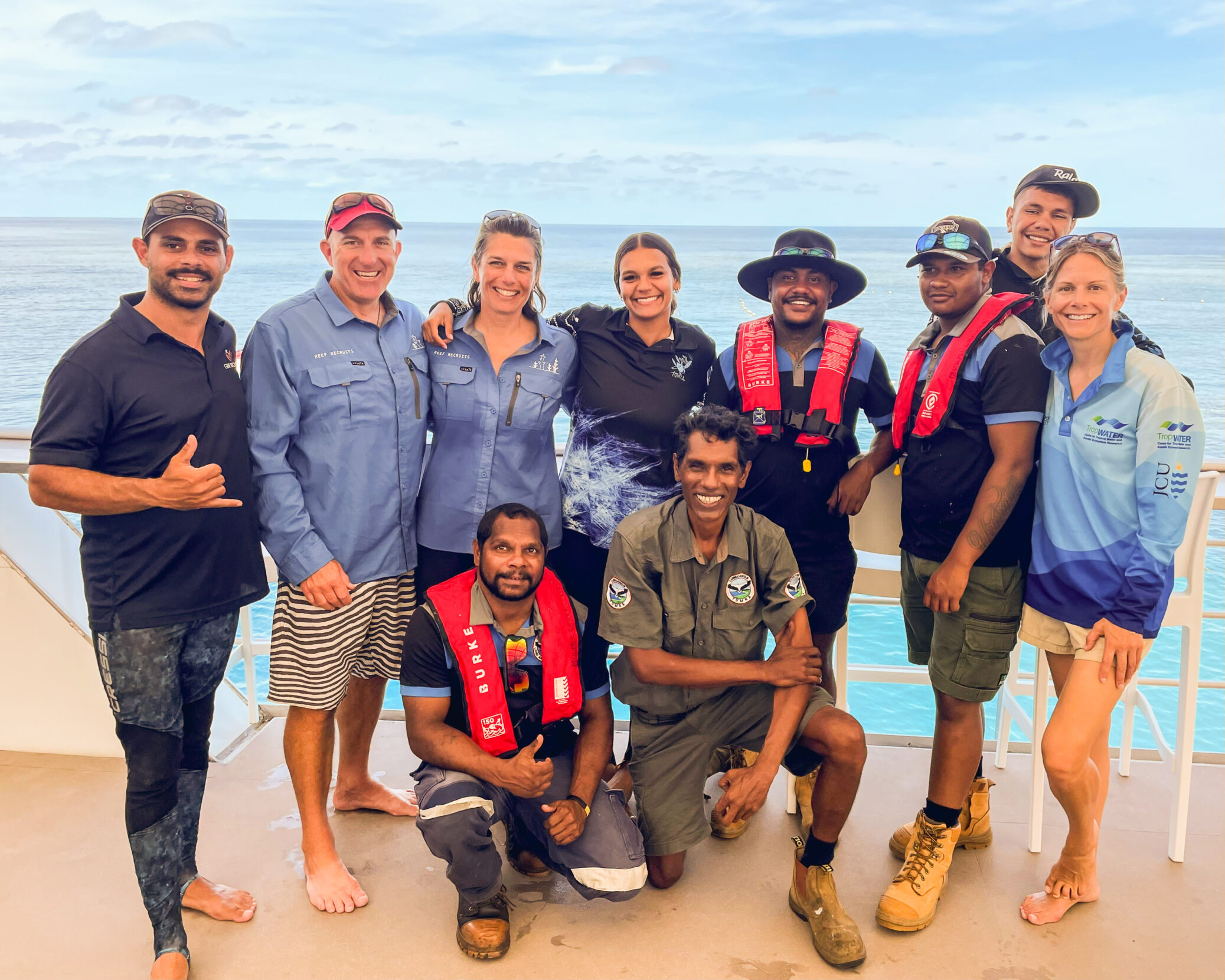
Sea Rangers from the Gunggandji and Yirriganydji Sea Countries pose alongside coral scientists for a group shot. Within a matter of days, the team will successfully rear and plant millions of baby corals. Photo: Dr. Katie Chartrand.
~~
It’s a perfect spring day in coastal Australia — the water and sky mirror each other’s balmy temperatures and crystal-clear hues of blue. On the lower level of the pontoon boat, as Touché and I clean our masks and pull on our flippers, Eric Fisher gives us an idea of what we are about to see.
Charismatic and energetic, Eric is part of the tourism side of the Reef Cooperative. He is the manager of GBR Biology, the organization that owns the pontoon boat where we are based. The boat’s official name, I learn, is Reef Magic. And the healthy reef nearby is called Moore. Eric is keen to take us on a daytime snorkeling tour to see another restoration technique that the team has been prototyping here in Gunggandji Sea Country.
Eric explains that what we are about to see are known as “reef stars,” a solution developed in Indonesia, where illegal blast fishing — a destructive practice using explosives to stun or kill schools of fish for easy collection — continues to damage coral reefs.
The three of us enter Sea Country together. But as soon as my face is underwater, I’m distracted from the task at hand. The GBR is a riotous cornucopia of life, and everything, including the water itself, is in constant motion. I watch an emerald-blue parrotfish grazing on algae — I can actually hear its buck teeth scraping the reef. Just beyond, a purple starfish lounges in a colony of yellow corals, like the color wheel come to life.
I want to stare longer, but the sea surges, pushing me along directly into the path of a school of tiny fish that deftly dodge me in unison. As I admire the velvety tentacles of a sea anemone, I spot a clownfish inside, peering back at me with one eye. I turn my head just in time to catch an elegant emperor angelfish gliding by, unmistakable with its fluorescent blue stripes.
I’m suddenly reminded that the GBR is about so much more than just corals. Its labyrinthine nooks and crannies are home to more than 5,000 species of fish and mollusks, plus sea turtles, crustaceans, sponges, anemones, and marine worms. I remember reading somewhere that the GBR provides habitat for 240 species of birds. It is one of the richest, most diverse, most complex ecosystems on earth. Yes, the GBR has incredible economic value: the tourism dollars, the fisheries, the storm protection. But for nature lovers like myself, it is even more than that. Being in its presence is emotional, evoking wonder and respect and a primeval awe. It’s gut-wrenching to think that we have put its 600,000-year-old existence in jeopardy.
“We can’t just stand by and do nothing.”
~~
Eric breaks my revelry by sweeping his arm in the universal underwater gesture for “follow me.” He takes us farther out into the sea, away from Moore Reef, until we’re above an open expanse of ocean floor, empty save for a series of human-made structures. These are the reef stars — essentially rebar covered in limestone. They resemble giant six-legged spiders, about three feet in diameter.
The Reef Cooperative thinks reef stars could be used to help restore reefs like Hastings, where extreme cyclones cause damage similar to blast fishing — pulverizing sections of the reef into shards. The plan is to deploy 200 reef stars at Hastings to provide a stable infrastructure for coral to attach to and live. The Reef Cooperative’s vision is to eventually create Traditional Owner-led snorkeling tours at Hastings to explain the negative impact of unfettered climate change on the GBR and to showcase the cutting-edge reef restoration work happening in Australia.
We dive down to investigate closer. I notice that each reef star has fragments of coral affixed to its legs. I kick back up to the water’s surface so we can talk. Eric and Touché surface beside me. The three of us tread water, bobbing in the gentle waves.
Eric explains that the fragments I saw are pieces of coral that naturally broke off from their home reef (fragmentation is another form of coral reproduction). The team collected the fragments and attached them to the stars to see how well they would take to the substrate and how fast they would grow.
“This is our more recent install,” Eric says, his eyes bright behind his mask. “From June.”
He is interrupted by the appearance of a very large fish, some three feet long and seemingly just as wide. The fish, a Māori wrasse I learn later, weaves back and forth between us. I squeal as it slides by me, grazing my side. Eric and Touché laugh.
“That’s Wally,” says Eric. “He hangs around us, kind of like our pet fish.”
I resist the urge to stroke Wally’s shimmering blue-green scales.
Eric goes on to explain that after a spawn, baby corals have a hard time settling on rubble beds, like the kind at Hastings from when parts of the reef got smashed up by a cyclone. It is too unstable, moving constantly with the tides and waves. A baby coral that does manage to secure to a shard then runs the risk of being crushed and killed as the rubble tumbles around. Installing reef stars in such an environment provides a stable surface for the babies to latch onto.
The GBR is a riotous cornucopia of life, and everything, including the water itself, is in constant motion.
“How long are we talking for regeneration?” I ask.
“I can show you,” Eric says. “Let’s go look at our first installation, from two years ago.”
We put our faces back into the water and begin swimming. Wally follows like a golden retriever with gills. I’m giggling inwardly at the sight of a hunk of brain coral the size of a boulder, as if the mind of the earth itself has suddenly been exposed, when I realize we have arrived. Eric dives down and spreads his hands out like he’s saying, “Ta-da!”
I descend to take a closer look, straining my eyes to make out any evidence of a reef star under all the corals and marine flora. I see no rebar. The natural environment has completely taken over. I feel my heart swell. I know that human beings cannot undo the damage we have done to the Great Barrier Reef, but it seems we can help it recover.
I extend both arms toward Eric with two thumbs up. I glance around, looking for Wally, but he has disappeared back into the wild.
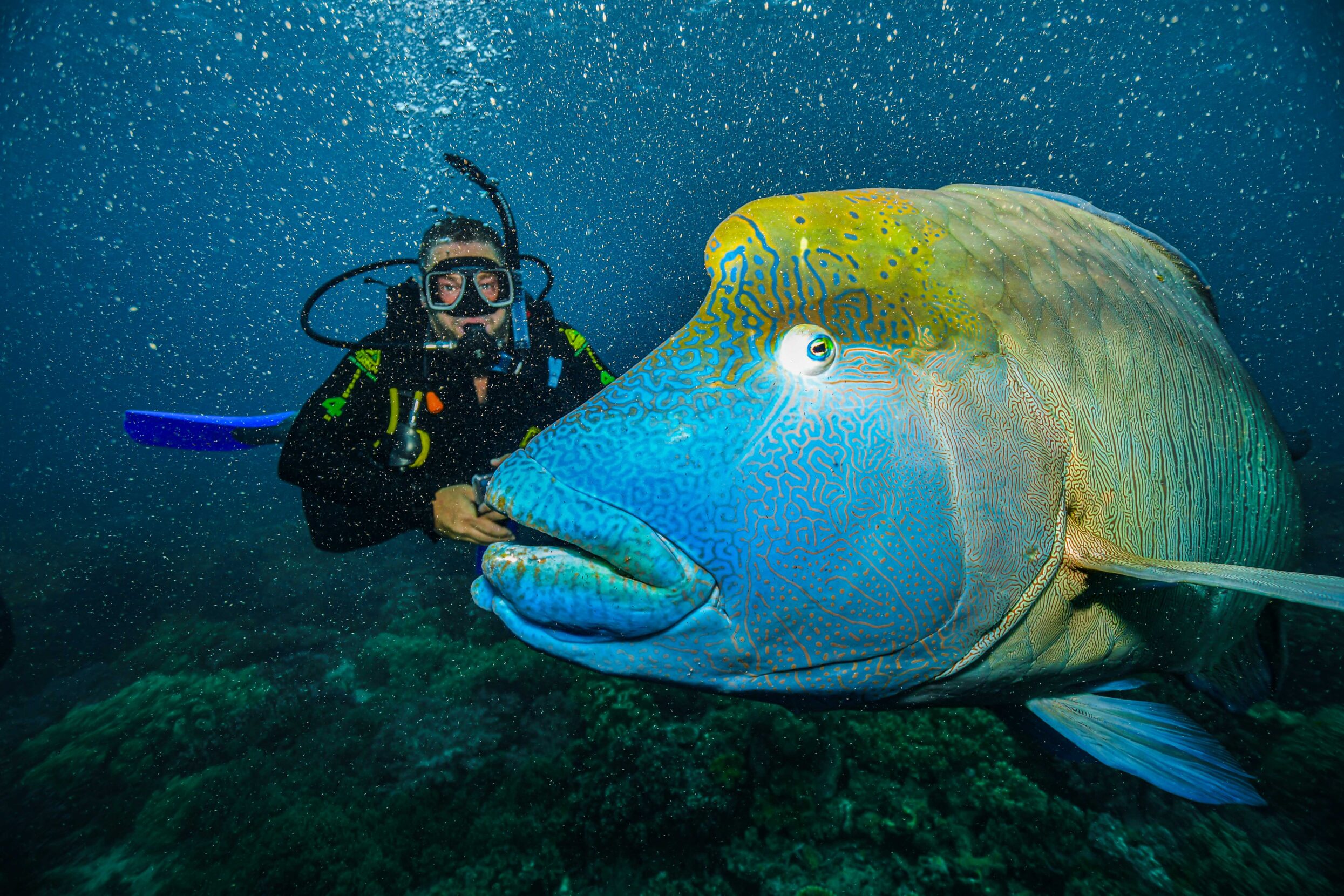
Wally, a friendly Māori Wrasse, poses with a diver for a photo. Photo: Experience Co.
~~
That night, the moon is waning, and the stars are bright. I am standing on the pontoon’s upper deck, tired but staving off sleep to glimpse some of the constellations that can’t be seen back home in Canada. My eyes comb the sky for the five bright stars that indicate the Southern Cross, the kite-like asterism that appears on Australia’s flag.
I ease myself into a lounge chair that is used by tourists in the daylight and lay flat on my back to stare up at the sky. In six days, the team will have successfully reared eight million baby corals and moved six million of them to Hastings Reef. The Yirrganydji Sea Rangers — Touché’s counterparts at Hastings — and the scientists will don snorkel gear and scuba suits and swim down to hand-deliver the baby corals to the damaged reef. In six months, they will return to measure the survival rate. Around that same time, they’ll install the first reef stars at Hastings in preparation for the next spawn. And when that next spawn occurs, the team will already be in position at Moore Reef, and everything I have witnessed will begin again.
I think of Moore Reef, underwater to my left, not far from the edge of the pontoon boat. Moore is not only a new parent but also a surrogate parent for Hastings. I wonder if she knows somehow.
“Country is all the living things, the stories, the spirits, and our responsibilities to them all.”
My eyelids are heavy. When I let them close, my brain replays scenes from my time underwater. I see the reef as vividly as if I’m once again with Sea Country, swimming among her magic gardens, surging and swaying with the rhythm of the ocean. I think of something Touché said about the spawn that did not quite make sense at the time, but suddenly rings true: “I can feel it in my blood.”
I recall the discussion in the lab about whether or not any of this will make a difference and how Katie said that this project is one of many, many efforts all over the globe to help coral reefs survive. I re-hear Kerry describing the corals and their energy-producing algae, “It’s a beautiful symbiotic relationship.”
My mind swirls around the idea of symbiosis. It crafts a bedtime story: On one enchanted evening in Australia in November, when the exact conditions of water temperature and tide had been met, the Great Barrier Reef spawned and entered into a new kind of relationship with human beings. From that point forward we would help rear the GBR’s offspring and transport coral babies en masse to sections of the reef that need them the most.
Symbiosis means one species cannot survive without the other. And while the Great Barrier Reef perhaps would have been better off without us, I know I don’t want to live in a world without the magnificent mother of Sea Country.
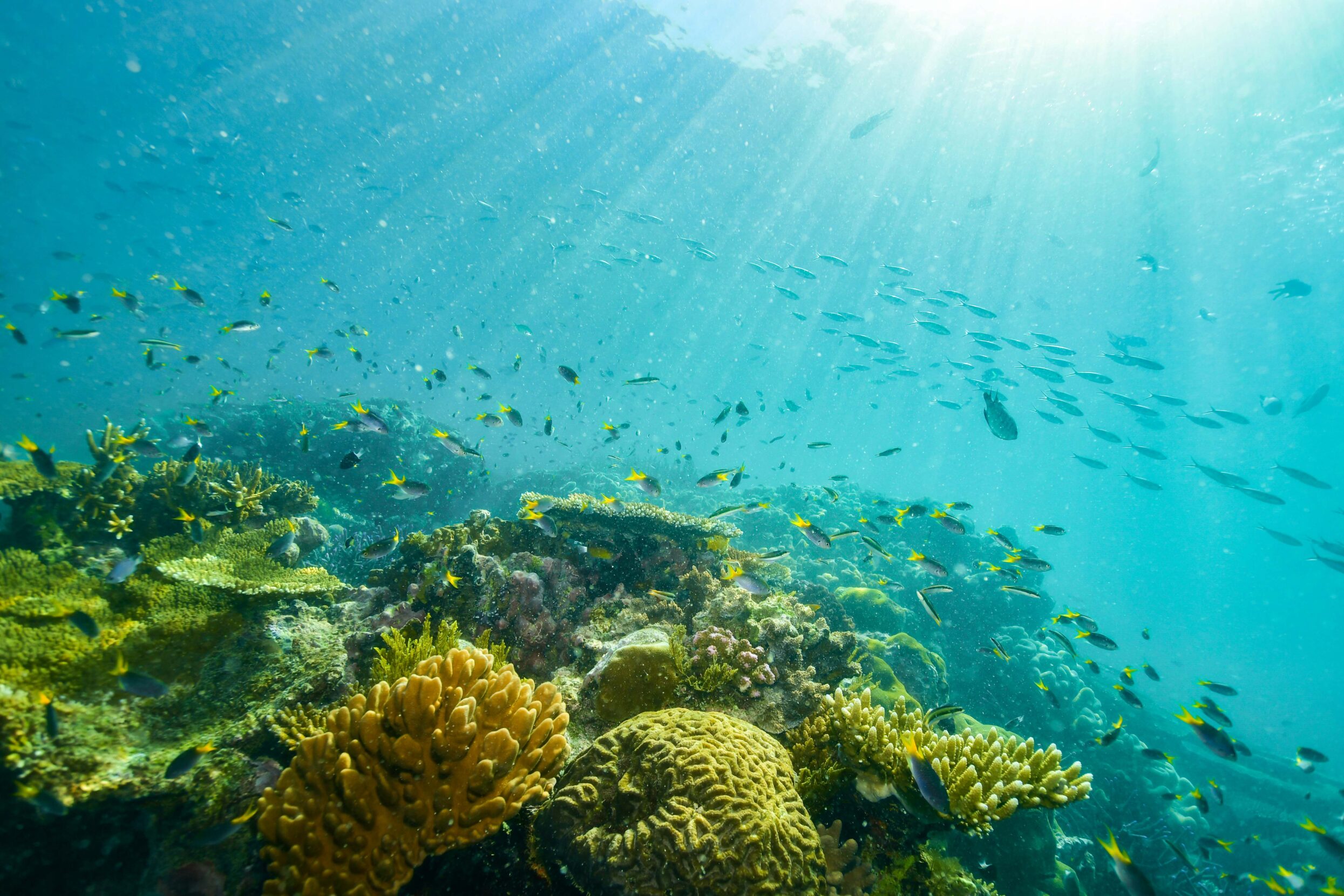
The future of the Great Barrier Reef remains uncertain, but perhaps the species responsible for its peril can also be the ones to save it. Photo: Experience Co.
Jayme Moye
Jayme Moye is an American-Canadian writer based in the mountains of British Columbia.

